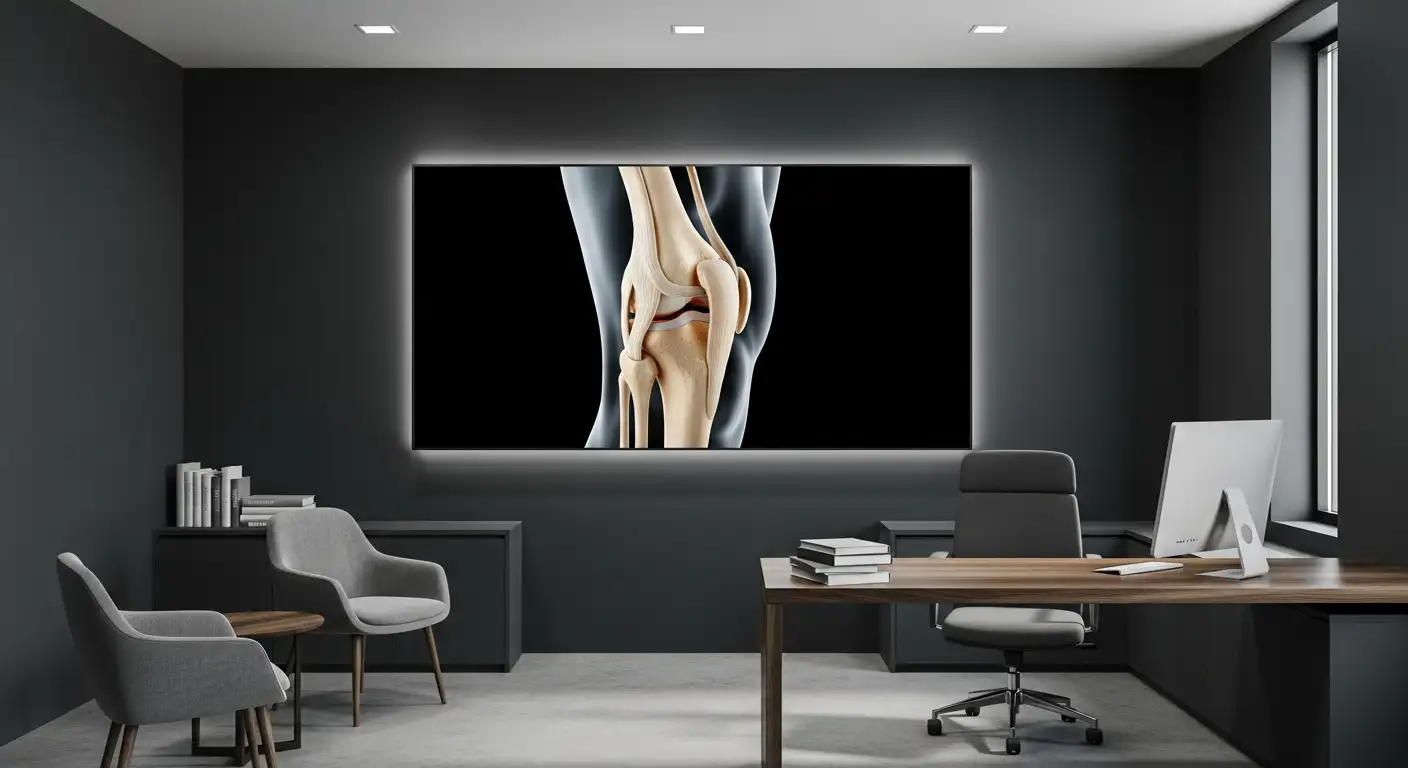Understanding Post-Surgery Swelling
Post-surgery swelling is a common occurrence that many individuals experience after undergoing knee surgery. This swelling is primarily due to the accumulation of excess fluid in the tissue surrounding the knee joint, which can extend to the lower leg and ankle. Understanding the anatomy of knee swelling and the expected timing and duration of swelling can help individuals manage this post-operative symptom effectively.
Anatomy of Knee Swelling
Swelling, defined as a protuberance of a body part, is typical in the knee after replacement surgery [1]. This swelling occurs due to excess fluid accumulation in the tissue of the knee joint, often as a result of the body's natural inflammatory response to surgery. While the swelling is most prominent in the knee, it can also extend to the lower leg and ankle, which is why strategies on how to reduce ankle swelling after knee surgery are important.

The intensity of the swelling can increase with activity and often appears worse at the end of the day. However, several strategies, such as elevating the leg, applying ice packs, and performing muscle pumping exercises, can help manage swelling and improve circulation.
Timing and Duration of Swelling
The timing and duration of knee swelling can vary from person to person but is typically most severe in the first few days following surgery. This moderate to severe swelling gradually subsides as recovery progresses, but mild to moderate swelling can persist for weeks or even months after surgery [4].
According to Bill Walter, swelling in the knee, lower leg, and ankle is common after a total knee replacement and can persist up to six months post-surgery. The level of swelling is typically dependent on the individual's activity level, with more active individuals likely experiencing more swelling.
Understanding the timing and duration of swelling can help set realistic expectations for recovery and assist in developing an effective swelling management plan.
Effective Swelling Management Techniques
In the aftermath of knee surgery, patients often experience swelling in the affected area, including the ankles. The severity can range from moderate to severe, especially in the first few days post-surgery. However, as recovery progresses, the swelling gradually subsides. To hasten the recovery and comfort of patients, it is crucial to implement several at-home strategies.
Role of Ice Application
Regular application of ice is a recommended course of action for managing post-surgery swelling. Ice induces vasoconstriction, or narrowing of the blood vessels in the region, which in turn decreases the influx of fluid to the area and thus reduces swelling. Ice application not only aids in swelling reduction but also alleviates discomfort, offering relief to the patient.
Importance of Leg Elevation
Elevating the leg post-knee surgery is another effective strategy for swelling reduction. Patients are advised to elevate their leg slightly above their heart level. This position facilitates fluid flow back to the body from the legs, thereby reducing swelling [1].
Moreover, leg elevation significantly alleviates pain, promotes proper blood flow, and accelerates recovery by creating a conducive environment for healing. The recommended duration for leg elevation is 3-5 days post-surgery, especially during the initial phase when swelling is most severe.
Alongside leg elevation, ankle pumps, which involve pushing the ankles down and up repeatedly, are recommended. These exercises not only help decrease swelling but also prevent deep vein thrombosis [1].
Use of Compression Stockings
Lastly, the use of compression stockings is suggested to manage swelling after knee surgery. These stockings apply gentle pressure to the legs, improving blood flow and preventing fluid from pooling in the legs. Consequently, they aid in reducing swelling and also decrease the incidence of deep vein thrombosis [1].
Understanding and implementing these techniques can play a crucial role in reducing ankle swelling after knee surgery. Decreasing swelling can aid in a faster recovery, improve mobility, and enhance comfort. Therefore, patients should consider incorporating these strategies as part of their recovery regimen.
Role of Physical Activity in Recovery
Physical activity plays a critical role in the recovery process following knee surgery. It aids in reducing swelling, improving range of motion, and rebuilding strength. This section focuses on early-stage exercises, the importance of cardiovascular exercise, and the limitations on physical activity.
Early Stage Exercises
In the initial six weeks post-surgery, the focus is on enhancing the range of motion. Exercises during this phase include movements like extending, squatting, stepping, and stretching, which primarily strengthen the quadriceps. These muscles tend to be weak in individuals needing or having knee replacements.
Patients may begin with bodyweight exercises and then progress to using elastic bands, ankle weights, light handheld weights, and eventually exercise equipment like a leg press or leg extension machine.
Importance of Cardiovascular Exercise
Cardiovascular exercise is a fundamental component of post-knee surgery physical therapy. It assists with muscle stretching, blood flow, healing, range of motion, and strength. Suitable cardio exercises include swimming, water aerobics classes, indoor biking, treadmill walking, and group exercise classes with aerobic moves.
In the timeline of recovery, patients should continue their prescribed exercise program two or three times a week until at least eight or 10 months after knee replacement surgery. From months 10 to 12, patients should continue knee workouts once a week while incorporating other types of activity [6].
Limitations on Physical Activity
While physical activity is essential for recovery, it's crucial to bear in mind that not all exercises are suitable after knee surgery. High-impact exercises, such as running or jumping, should be avoided to prevent undue stress on the knee. Instead, opt for low-impact activities that promote cardiovascular health without compromising the integrity of the knee joint.
Listening to your body is vital during this recovery phase. Pushing through pain or discomfort can lead to further complications. Therefore, while it's important to challenge yourself during recovery, it's equally important to respect your body's limitations and adjust your physical activity accordingly.
Remember, the goal of physical activity after knee surgery isn't just about regaining strength or range of motion. It's also about regaining confidence in your ability to move and perform daily activities without pain or discomfort. By incorporating a variety of exercises into your recovery plan, you can work towards achieving this goal and minimize ankle swelling after knee surgery.
Medication and Swelling Control
After knee surgery, managing pain and reducing the risk of infections are crucial aspects of the recovery process. By understanding how to effectively control pain and avoid complications, patients can work towards a swift and smooth recovery.
Pain Management Post-Surgery
Pain management after knee surgery is typically addressed through the use of non-narcotic medications. Professor Walter, a leading orthopedic surgeon, suggests the use of Panadol or Panadeine as the primary pain relief medication post-discharge. If stronger pain relief is required, patients are advised to consult their general practitioner.
In addition to medication, the use of ice packs, leg elevation, and gentle exercises can also help manage pain and reduce swelling. These techniques can be particularly effective for managing ankle swelling after knee surgery, a common occurrence that can persist for up to six months post-surgery.
Risks of Infections
Infections pose a significant risk to patients recovering from knee surgery, particularly if they spread to the replaced joint. Therefore, it is crucial to promptly address any infections, including tooth decay and mouth infections.
Special attention should be given to oral care post-surgery, and dentists should be informed about the joint replacement before any dental procedure. By taking these precautions, patients can reduce the risk of infection and ensure a smoother recovery process.
In conclusion, medications play a key role in the management of post-surgery pain, and careful attention to potential infection sources is essential in the recovery process. By following these guidelines, patients can effectively manage pain and swelling, reducing the time required for recovery and improving their overall quality of life.
Lifestyle Adjustments for Recovery
Recovery from knee surgery involves more than just medical treatment. Lifestyle adjustments, such as modifications in sleep habits, diet, and the resumption of normal activities, also play a pivotal role in reducing ankle swelling after knee surgery.
Sleep and Rest Considerations
Adequate rest is crucial for a successful recovery. The body's natural recovery systems operate most effectively during sleep. It is recommended to get at least 8 hours of restful sleep per night. This helps the body recover and repair, reducing inflammation and swelling. Positioning the leg properly while sleeping can also aid in controlling swelling.
Dietary Adjustments
Changes to diet can significantly aid in recovery, although specific recommendations can vary depending on individual health needs. Generally, a balanced diet rich in protein, vitamins, and minerals supports tissue repair and boosts the immune system. Keeping hydrated and limiting sodium intake can also help reduce swelling. Always consult with a healthcare provider or registered dietitian before making significant dietary changes post-surgery.
Resuming Normal Activities
Resumption of normal activities should be gradual and carefully managed. During the first six weeks post-surgery, activities should be limited, with a focus on walking with support and gentle swimming in the shallow end after receiving permission to wet the wound. High-impact activities such as running, jogging, and extreme poses like those in yoga are not recommended at any time after knee replacement surgery.
Patients are advised to continue their prescribed exercise program two or three times a week until at least eight or 10 months after knee replacement surgery. From months 10 to 12, patients should continue knee workouts once a week while incorporating other types of activity.
Walking frequently throughout the day is also essential to improving strength and endurance after knee surgery, helping individuals return to normal activities.
Resuming sexual activity is a personal decision that each patient can make when they feel ready after knee replacement surgery.
By incorporating these lifestyle adjustments into their recovery plan, patients can effectively manage swelling and accelerate their return to normal activities. It's important to remember that everyone's recovery journey is unique, and what works best for one person might not work for another. Always consult with healthcare providers when making significant changes to recovery plans.
References
[1]: https://www.cortho.org/knee/swelling-after-knee-replacement/
[2]: https://www.tsaog.com/blog/2023/10/30/how-to-reduce-foot-and-ankle-swelling-after-surgery/
[3]: https://www.allinahealth.org/health-conditions-and-treatments/health-library/patient-education/total-knee-replacement/after-surgery/knee-exercises
[4]: https://www.wikihow.com/Reduce-Swelling-After-Knee-Surgery
[5]: https://www.bonefoam.com/blog/post-knee-replacement-surgery-leg-elevation
[6]: https://www.hss.edu/article_exercises-after-knee-replacement.asp
[7]: http://billwalter.com.au/your-surgery/after-your-knee-surgery/after-knee-replacement-surgery/





